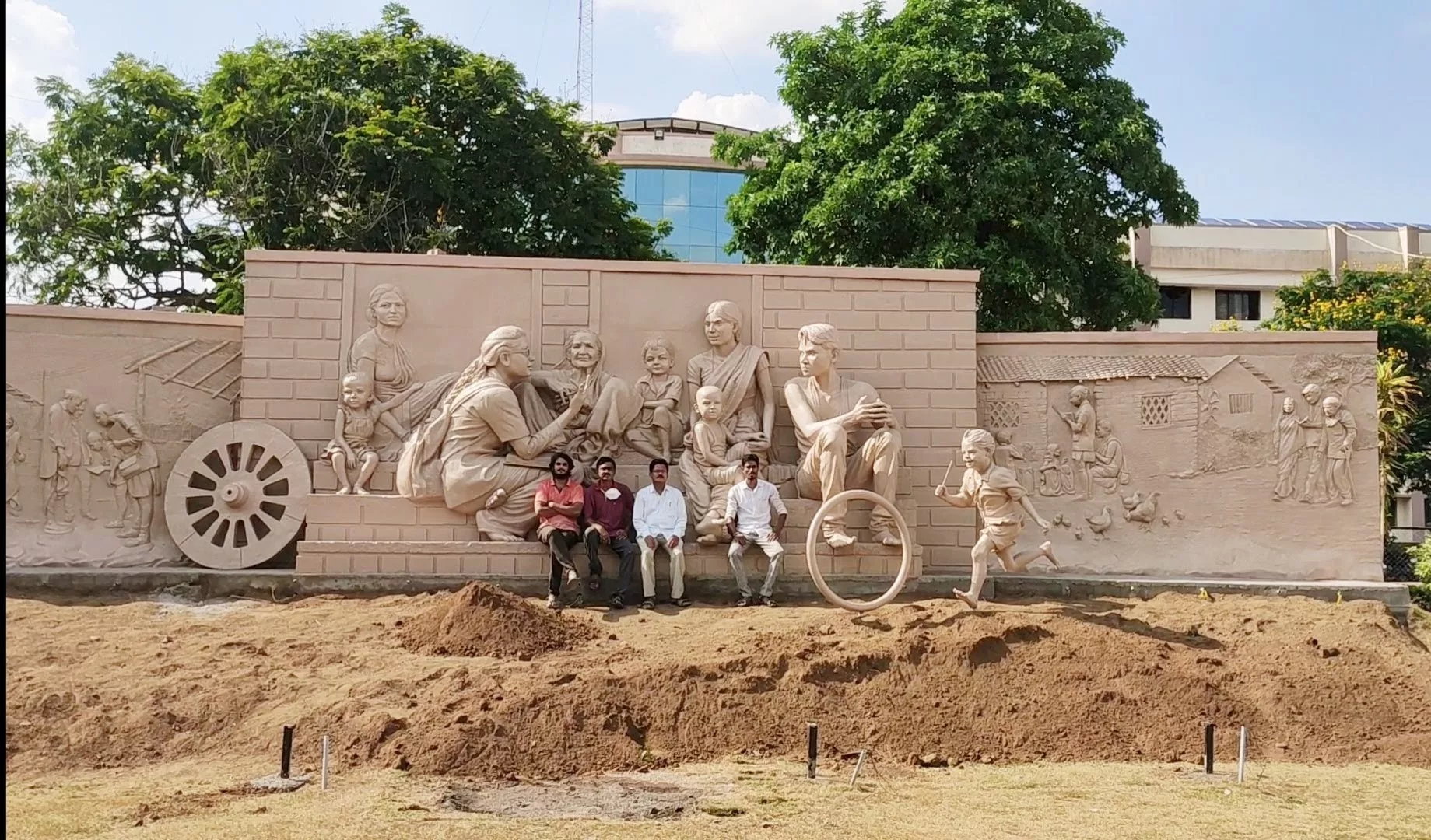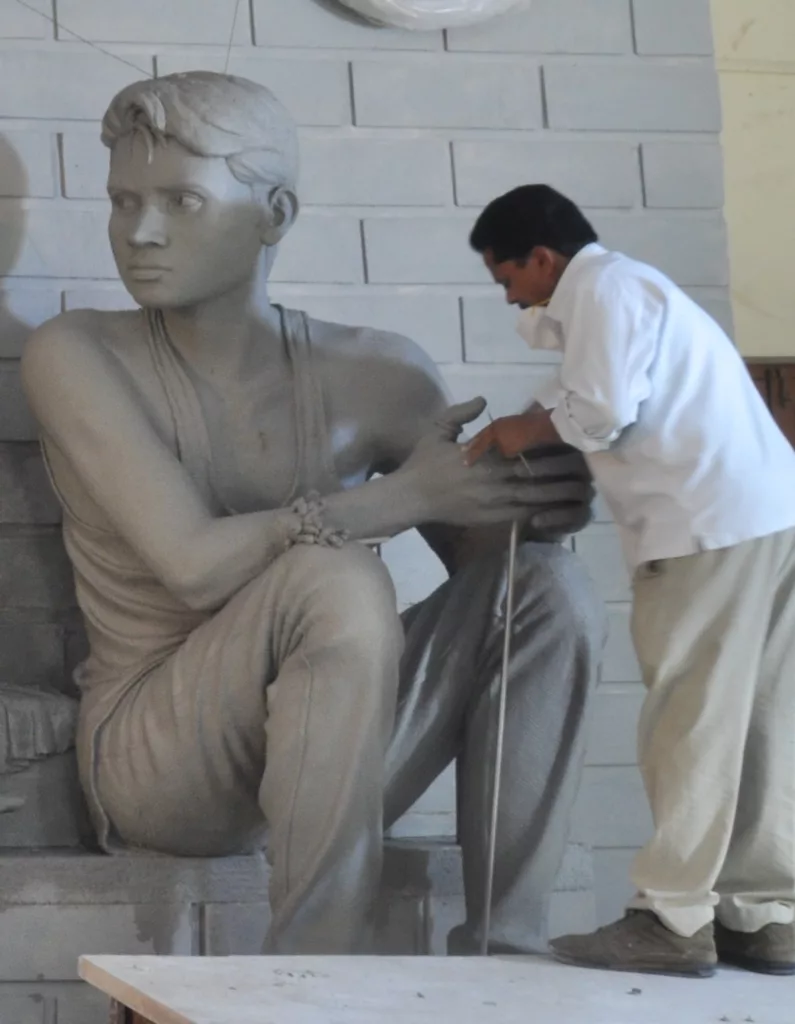
Capturing Life in Rural India: The Making of the MGIMS Mural
Dinesh Gudadhe and Ashok Wahiwatkar.
Two talented artists at MGIMS transformed a real photograph into a magnificent work of art that now proudly stands on the MGIMS hospital campus.
Along with Hitesh Chappanghare, the trio completed an incredible eight-month-long journey of creating a stunning mural.
Crafting a mural takes time, talent, and tireless tenacity. Let me share with you the backstory of this magnificent marvel.
Every year, MGIMS medical students adopt families in a village to gain insight into how social factors influence healthcare practices in real communities.
The year 2014 was no exception. That year, the entire batch of medical students spent two weeks to living with, learning from, and serving the people of Dhanora, a village located 8 km from Sevagram.
One Sunday, Dinmesh Gudadhe, a 44-year-old artist from the Community Medicine department of MGIMS, was inspired to snap a photograph of a medical student sitting at the doorstep of a family in the village.
Little did he know that this mortal photograph, out of the hundreds he had taken, would one day be transformed into an immortal mural. The photograph sparked inspiration for the mural and also became the cover of the 2014 MGIMS annual report.

The mural, 12 feet high and 48 feet wide, features a female first-year medical student from the MGIMS 2014 batch, seated at the doorstep of a humble hut in the village, adorned in a white medical apron and spectacles. Her eyes are brimming with curiosity as she endeavours to understand what makes the villagers ill and how they cope with illnesses. Her hair is neatly braided and cascades over her shoulders, while a large backpack rests on her back, symbolizing her eagerness to learn and serve.
Beside the medical student, a white-haired old lady, dressed in a vibrant green blouse and an eye-catching orange and yellow-bordered saree, sits contentedly on the doorstep of her humble abode. The old lady is flanked by two young women, both of whom are attentively listening to the conversation between the medical student and the old lady.
Just a few steps away from the medical student and the group of women, a young man in trendy jeans sits on a small wooden stool, holding a mobile phone in his hand. In the lap of the old lady, a young infant gazes directly into the camera, capturing the innocence and purity of youth. Nearby, a one-year-old girl and a two-year-old boy sit blissfully unaware of the scene unfolding around them, basking in the warmth of the sun and the love of their community. The mural is a stunning representation of the interconnectedness of life in Dhanora village and the importance of community in rural India.

As the viewer’s gaze wanders over the mural, they will notice a young boy standing next to a tire, his feet playfully kicking up dust as he runs after the tire, which rolls ahead of him. The sheer delight on the young boy’s face is evident, as his wide grin radiates pure joy. The simple tire toy brings him boundless excitement and happiness, exemplifying the unbridled innocence and simplicity of life in the village.
The front brick wall of the humble hut is rugged and unplastered, with the natural texture of the bricks clearly visible. The steps the medical student and the family members are sitting on are also rough and unfinished, with the mud between the bricks showing through. The contrast between the raw, unpolished quality of the wall and steps, and the intricacy and detail of the figures creates a striking visual impact in the mural.

Dinesh, Ashok and Hitesh dedicated eight months of their time and effort, getting their hands and clothes dirty with clay, plaster of Paris, and paints to craft this masterpiece.
The mural is not just a work of art, but also a powerful symbol of MGIMS’s commitment towards providing a holistic education that is grounded in real-world experience and community service. The artists said, “It captures a special moment of human connection and curiosity, reminding us of the beauty and richness of life in rural India.”
The addition of Lao Tzu’s poem added a meaningful touch to the artwork’s display in the garden.
Dinesh and Ashok are humble. They won’t boast about their artistic achievements. It was difficult to get them to talk about it. They prefer to let their brushwork do the talking, a rare trait in today’s era of artists relying heavily on social media to hype the beauty of their work.


बहुत सुंदर वर्णन इस महत्वपूर्ण भिंतिचित्र का। न केवल कलाकार ने ग्रामीण जीवन के विविध पक्षों और आयाम को इस भिंतिचित्र के माध्यम से जीवंत किया है, लेखक ने अपनी भाषाई पकड़ कायम रखते हुए संजीव वर्णन किया है। एक- एक हिस्से के वास्तविक वर्णन ने इस विवरण को अपने आप में एक ऊंचा आयाम प्रदान किया है। मूर्तिकार और विवरण लेखक निश्चित ही बधाइयों के पात्र हैं।